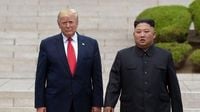As US President Donald Trump embarked on a high-stakes Asia tour in late October 2025, the world’s attention was once again drawn to the simmering nuclear standoff on the Korean Peninsula. The former president, known for his unconventional diplomatic overtures, set the stage for renewed speculation about a possible fourth meeting with North Korean leader Kim Jong Un—a prospect that has both raised eyebrows and reignited debate over the future of denuclearization talks.
Speaking to reporters aboard Air Force One on October 25, Trump made a remark that instantly rippled through diplomatic circles: “I think they are sort of a nuclear power,” he said, referring to North Korea. “When you say they have to be recognized as a nuclear power, well, they’ve got a lot of nuclear weapons, I’ll say that.” According to The NY Post, Trump’s comments acknowledged Pyongyang’s growing arsenal without formally recognizing its status as a nuclear-armed state—an important distinction that could have far-reaching implications for international negotiations.
Trump’s Asia trip, which included stops in Malaysia, Japan, and South Korea, was officially focused on trade, with a scheduled meeting with Chinese President Xi Jinping at the Asia-Pacific Economic Cooperation (APEC) Summit on October 30. But as Reuters and BBC reported, North Korea and the possibility of a Trump-Kim summit quickly overshadowed other agenda items. US media outlets revealed that the Trump administration had quietly explored the logistics for a potential meeting with Kim during the trip, though no official confirmation was forthcoming.
“I’d be open to it, 100%. I got along very well with him, Kim Jong Un,” Trump told reporters, adding that the two leaders had established a rapport during his first term. “They don’t have a lot of telephone service. They have a lot of nuclear weapons, but not a lot of telephone service,” he quipped, as reported by The NY Post. Trump’s willingness to “put out the word” about a possible meeting only fueled further speculation.
South Korean officials appeared cautiously optimistic. Unification Minister Chung Dong-young, speaking to Yonhap news agency and cited by Reuters, suggested there was a “considerable” chance of a Trump-Kim meeting during the president’s visit. He urged both leaders to “make a bold decision,” echoing regional hopes for a diplomatic breakthrough. Meanwhile, tours of the Joint Security Area (JSA)—the heavily fortified site of Trump and Kim’s 2019 Panmunjom encounter—were temporarily suspended from late October to early November. Minister Chung noted that North Koreans had been “sprucing up” the area, cleaning and tending flower beds, a telltale sign that preparations for a high-profile event might be underway.
Despite the mounting anticipation, a senior US official, speaking anonymously to reporters, was quick to tamp down expectations: “Such a meeting is not currently on the schedule for this trip.” A White House official reiterated that “US policy on North Korea has not changed. President Trump remains open to talking with Kim Jong Un, but such a meeting is not currently on the schedule for this trip.” Still, the official acknowledged the history between the two leaders: “President Trump in his first term held three historic summits with North Korean Leader Kim Jong Un that stabilized the Korean Peninsula.”
The Trump-Kim relationship has always been a study in contrasts—alternating between fiery rhetoric and surprising cordiality. Their first summit in Singapore in 2018 was historic, marking the first-ever face-to-face meeting between a sitting US president and a North Korean leader. The two conducted what a joint statement called a “comprehensive, in-depth, and sincere exchange of opinions on the issues related to the establishment of new US-DPRK relations.” However, the optimism was short-lived. Their second summit in Hanoi in February 2019 ended abruptly without a deal, as disagreements over the scope of denuclearization and sanctions relief proved insurmountable.
Yet, the two leaders crossed paths one more time in June 2019 at the DMZ, with Trump becoming the first sitting US president to step into North Korean territory. He took 20 steps into the North, shook hands with Kim, and the pair agreed to revive talks on North Korea’s nuclear program. “I was not aiming to make a deal fast, but rather to get it right,” Trump said at the time, as reported by Fox News Digital. Despite these overtures, negotiations stalled, and Pyongyang has since doubled down on its nuclear ambitions.
North Korea has repeatedly declared itself an “irreversible” nuclear state—a claim that has alarmed Washington, Tokyo, and Seoul. According to BBC, Pyongyang’s growing nuclear and missile capabilities continue to complicate efforts toward denuclearization, while China and Russia have often advocated for dialogue and restraint to avoid military escalation. The world’s powers remain locked in a delicate balancing act: recognizing North Korea’s arsenal risks legitimizing its nuclear status, yet continued sanctions and pressure have failed to halt its weapons development.
Kim Jong Un, for his part, has signaled openness to renewed talks—albeit on his own terms. He recently remarked that he had “fond memories” of previous meetings with Trump and would be willing to engage again, provided the United States dropped what he called its “delusional” demand that Pyongyang relinquish its nuclear weapons. This stance underscores the core dilemma: North Korea sees its arsenal as a guarantee of regime survival, while the US and its allies view denuclearization as non-negotiable.
As Trump’s Asia trip unfolded, the suspension of JSA tours and the flurry of activity on the North Korean side of the border kept observers guessing. Was this all elaborate stagecraft, or the prelude to another dramatic handshake? For now, the answer remains elusive. What’s clear is that the stakes could not be higher. Each move on the peninsula reverberates far beyond the region, influencing global security, alliances, and the ever-shifting calculus of nuclear diplomacy.
Whether or not Trump and Kim meet again, the unresolved tensions and complex personalities at play ensure that the world will keep watching—hoping for progress, wary of setbacks, and acutely aware that history on the Korean Peninsula is still being written, one unpredictable step at a time.
